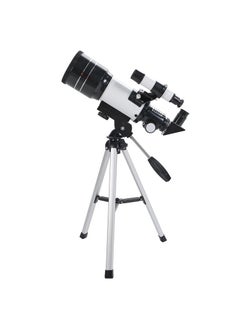OverviewLuminous aperture: 70mm (2.4 inches)
Focal length: 300mm. f/4
Oblique mirror: 90
Warp and weft table and aluminum tripod
Maximum height: 38cm
Standard 0.965 inch accessories include:
Eyepiece: H6mm, H20mm, 3x Balov mirror, 1.5x positive image mirror
Maximum magnification of this model: 150 times (objective lens focal length/eyepiece focal length * several times Balof factor=maximum magnification)
The aperture is the most important indicator for selecting a telescope, and it is directly proportional to its clarity and price.
A. Regarding features:
This one can weigh about 2 kilograms gross and can view the circular island of the moon. Tripod height: 38CM.
B. Regarding configuration:
The focal length is 300mm, the aperture is 70mm, and it is equipped with two eyepieces: H6 (for daytime viewing) and H20 (for night viewing of the moon). In addition, it is equipped with a 3x Baroff lens, a 1.5x orthophoto lens, and a moon lens. Lunar Mirror: Because there is a large amount of reflected light interference when observing a full moon, using a lunar mirror can eliminate these interferences and make the surface of the moon more visible. When using, please screw the moon mirror into the lower thread of the eyepiece and then connect the eyepiece to the zenith mirror.
C. Regarding multiples:
The magnification of H6mm and H20mm is 300/6=50 times and 300/20=15 times, respectively. If a 3x Balov mirror is selected, the magnification will be 50X3=150 times, and 15X3=45 times; Adding a 1.5x orthophoto mirror, the imaging is orthophoto, and the magnification is 50X1.5=75x and 15X1.5=22.5x, respectively. Namely: minimum magnification: 15 times, maximum magnification: 150 times.
D. Calculation formula:
Objective lens focal length/Eyepiece focal length * How many times the Balov multiplier=Maximum magnification
Objective focal length/Eyepiece focal length=Magnification factor
E. Installation sequence:
Support the tripod first,. Then install the lens tube. After fixing the lens barrel, install a star seeking mirror on top of the barrel (to preliminarily search for the target object), and then install an eyepiece (choose 1 out of 2 eyepieces). After setting a big goal, then adjust it with different eyepieces. Note that when using it for the first time, be patient and then be patient! The possibility of astronomical damage is very, very small, let alone that we have rigorously checked every telescope before sending it out.
F. Mainly depends on comprehensive factors such as aperture and focal length.
For example, if the windows of a house are large, the light will naturally be good and the view will be clear, which is the same principle.
G. When using a 3x Baroff mirror, first install the Baroff mirror and then the eyepiece.
(To install a Barov mirror, you need to remove the cover on the device where the eyepiece is installed.)
H. Note: Only one eyepiece (H6mm, H20mm) can be selected for installation at the same time.
Two magnifying mirrors (3x Balov mirror and 1.5x orthophoto mirror) can only be selected at the same time.
I. Of course, multiples are not unique, but mainly depend on a combination of factors such as aperture and focal length.
For example, if the windows of a house are large, the light will naturally be good and the view will be clear, which is the same principle.
Free & Easy Returns
Best Deals

